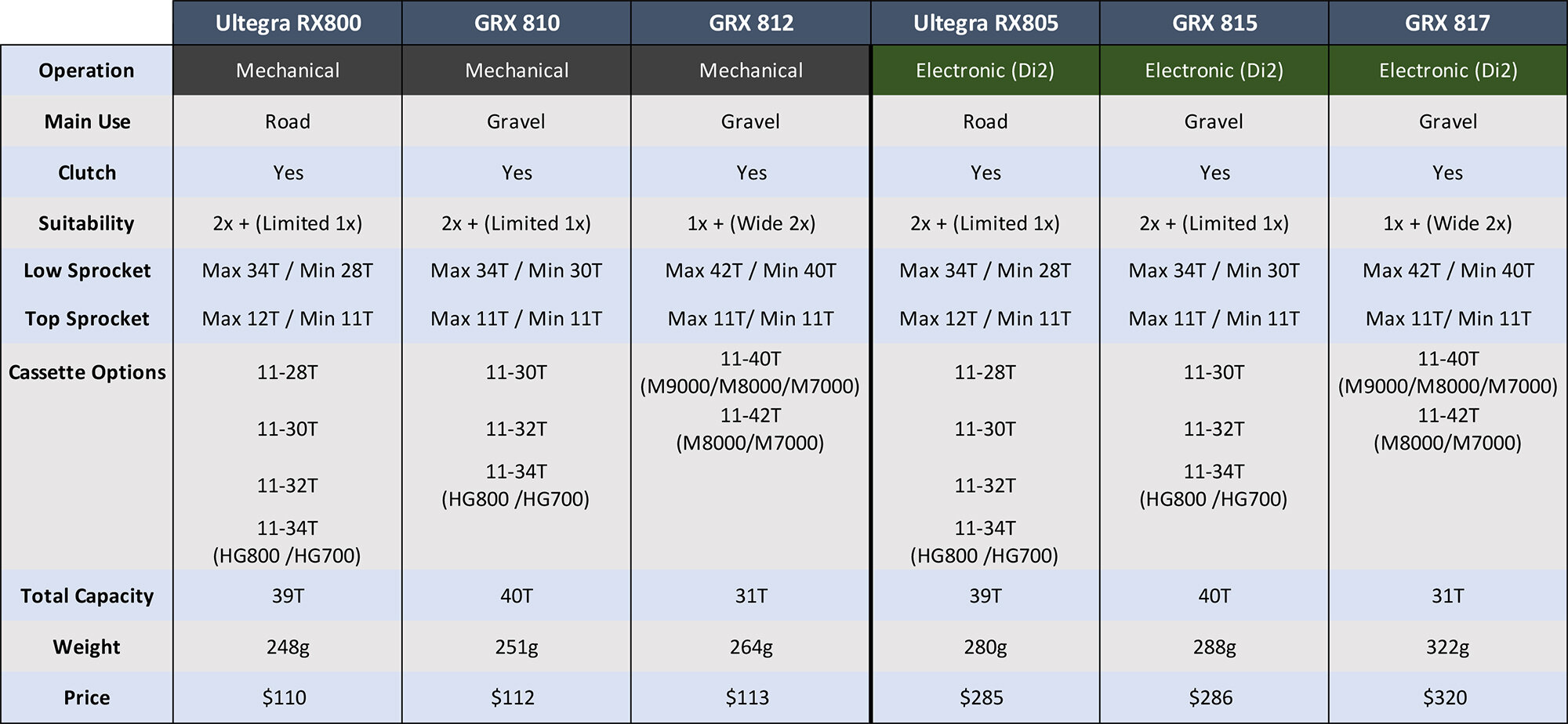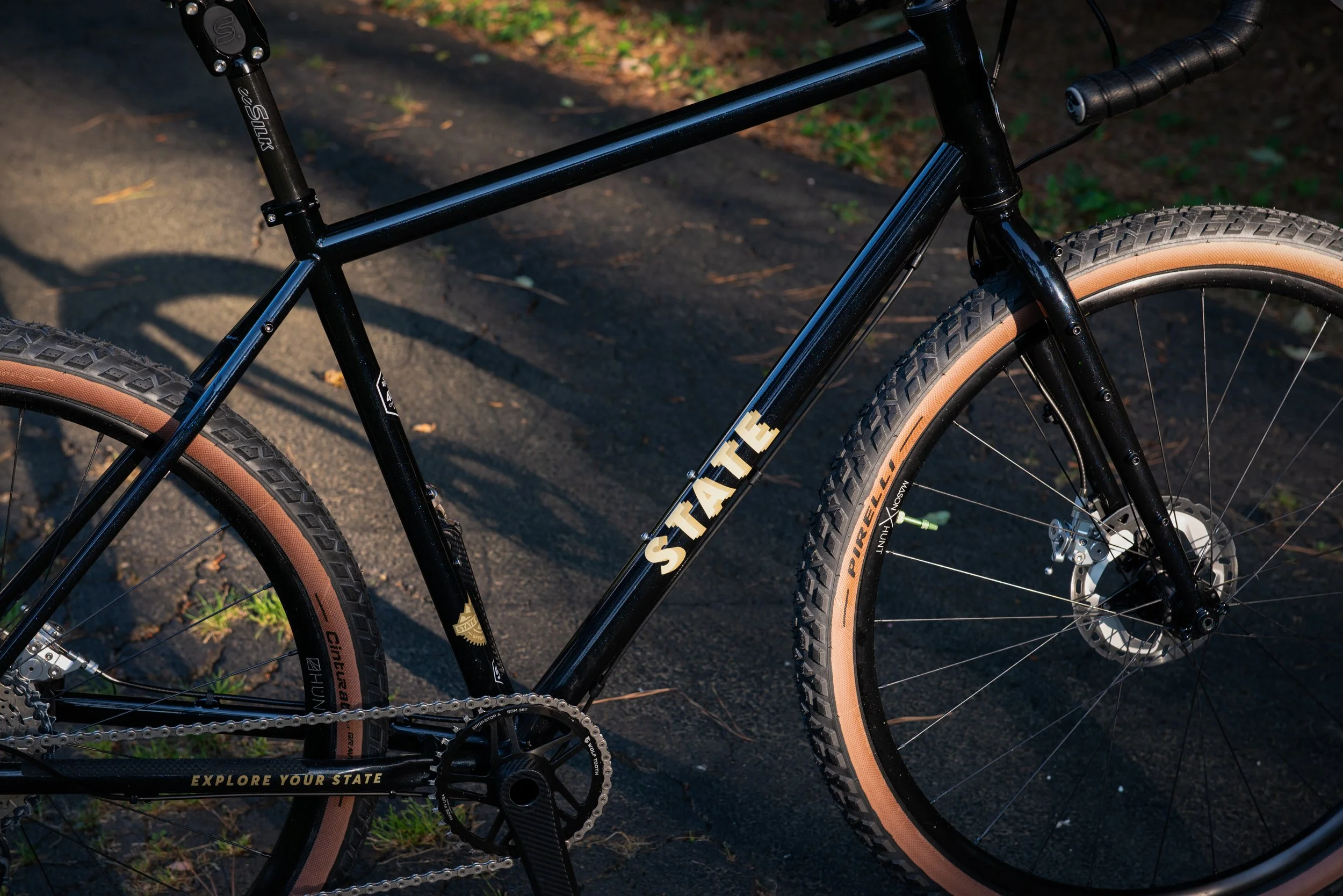Shimano Gravel Derailleurs: GRX & Ultegra RX Compared
Disclaimer: This post contains affiliate links, through which we earn a commission.
I crashed! Yep, a few months back I took a nasty tumble while riding my gravel bike. It was a rainy afternoon and my front wheel slipped out beneath me on some wet pavement. I was sent crashing down on my right side and skidded across the pavement. Fortunately, it was mostly just some road rash damage to my body, but the bike did land heavily on the rear derailleur, which got scuffed up quite a bit. The gearing was immediately off after the crash and I feared that the derailleur might have gotten damaged during the impact. First things first, I tended to my wounds and then I scraped up enough courage to perform the post-crash damage assessment. Closer inspection revealed that the damaged was limited to a bent hanger and the derailleur still worked fine. The experience motivated me to share some information that I gathered about all the different Shimano gravel derailleurs on the market, and hope that it can simplify the process of finding the right derailleur that will work with your budget and needs.
GRX 812: Damaged Derailleur
The Derailleur Search
If you’ve followed other articles on this blog, then you will know that my gravel bike, the 3T Exploro Pro GRX model, is equipped with a Shimano GRX 812 rear derailleur. The derailleur has performed flawlessly (up until the crash), but I was willing to extend my search to see what other alternatives were available beyond the GRX 812 model. This led me down a Shimano GRX rabbit hole where I discovered all the little details that distinguish the Shimano GRX rear derailleur models from each other.
During my search, I also ran into the Ultegra RX range of derailleurs, the predecessor to the GRX derailleurs. With so many options available, all the small differences tend to get a bit confusing. That’s why I decided to get all the information condensed into one article to allow for easier comparisons. Since I’m a bit of a spreadsheet nerd, naturally I decided to compile all of my research into one quick reference data table.
My hope is that this information can help save you some time when trying to figure out which derailleur is best for your gravel bike.
GRX vs Ultegra RX Comparison: Overview
Which one is right for you?
“It depends.” We’ve all heard that answer when it comes to asking questions about what cycling gear will work best. The same is most certainly true when it comes to picking the correct derailleur for your gravel bike. It depends on where you ride, your budget, how much you value electronic shifting, weight considerations and durability. While you can easily draw your own conclusions from the table above, I’ll walk you through my top 5 take-aways when looking at the Shimano gravel derailleurs that are available today.
1) Where do you ride?
This is by far the most important point to consider when you decide which derailleur to go for. There are two things to take note of here: road vs gravel riding and also the type of terrain you ride on.
You’ll note that I labelled the Ultegra RX derailleur as a “road” derailleur. This relates to the fact that Shimano first launched the Ultegra RX derailleurs as a compliment to their Ultegra R8000 range, the main difference being the clutch mechanism that comes with the RX variant. It gave Shimano road riders the first taste of a derailleur that could reduce the amount of chain slap when going over rougher roads. Gravel riders quickly jumped at the opportunity to fit the derailleur to their bikes and pushed the limits of what could be done. Shimano clearly took note of the trend and followed up on the demand by launching their first dedicated gravel groupset in the form of GRX. GRX added some additional burliness to Ultegra RX to make it better suited for gravel riding. That said, the Ultegra RX derailleur is still a solid option when it comes to gravel riding, especially if you don’t intent to bash around on crazy rough trails and gravel roads. If you are going to use your gravel bike more like a mountain bike, then the best option might be to stick to the GRX line-up.
Next you have to consider the type of terrain you ride most often and the gear selections that are required. This is where things can get really complicated and I would need to go into multiple debates about the benefits of a 1x vs 2x drivetrain set-up in order to be as thorough as possible. Those discussion will have to be left for another day. To keep things simple, take a look at my table and note the low sprocket limitations specified by Shimano. That limitation will drive the potential cassette options that are possible with each derailleur. As a last step, you can review my “suitability” description. While the RX800, GRX810, RX805 and GRX815 are all listed to be 2x specific (given the 34T limit), you should still be able to run a more compact 1x set-up if the area where you ride isn’t too hilly and you have the correct front chainring size. Its also possible to build a super wide 2x set-up with the two 1x specific derailleurs (GRX812 & GRX817), but be sure to keep an eye on the total capacity. Total Capacity = (Large Chainring - Small Chainring) + (Largest Cog- Smallest Cog).
Images displayed: GRX 812, GRX 810, Ultegra RX800 & GRX 817
2) Budget
Any cyclist who wants to stick to a budget will know that the desire to purchase new bike parts always outweighs the available funds to make such purchases. Clearly the electronic options available in the GRX and UltegraRX line-up come with a higher price tag than the mechanical versions. This brings us to the next point.
3) The importance of electronic shifters
Full disclaimer, I’ve never ridden a bike that has electronic shifters and can’t really make any claims about how much better they are to operate. That said, I’ve seen countless reviews of people absolutely swearing by electronic shifting, stating that they will never go back to mechanical shifting. Fair enough. I can most definitely see the benefits that come with this modern shifting system. I can only imagine that a precise shifter requiring minimal hand movement must be worth every cent.
There are also a few downsides to electronic shifting that warrant consideration: Batteries do run out (often at the worst possible time), electronic systems (especially Shimano’s) are much more complex to set-up, it costs more and to top it all off, the electronic shifters actually adds weight to the bike. It will ultimately come down to personal preference whether Shimano Di2 will work for you. If you are simply replacing a broken derailleur, you will unfortunately be forced to just go with what components are already on your bike. If you already have electronic, then only the Di2 options will match with your existing parts.
4) Weight
I hinted at this is in the previous point, but do note how the electronic derailleurs come in a bit heavier when compared to the mechanical versions. You’d think that the higher-end products should automatically also mean a reduced weight, but this is not the case when adding on a whole bunch of electronics to a regular derailleur.
One more point to note with the weight comparison is how the Ultegra RX line-up weighs in lighter than the GRX components. This comes back to what I mentioned earlier when I said that the Ultegra RX line-up acted as a predecessor to GRX and some additional strength got added to the GRX line-up to make it better suited for rougher gravel conditions. Clearly that extra strength did come with a slight weight penalty.
5) Durability
Durability ties in closely with the weight consideration and also with the “where you ride most often” question. When deciding between the Ultegra RX and GRX options, it might be worth considering that the GRX components were purposefully designed for gravel riding and the demanding conditions that go along with it. If long-term durability is what you are after, then you should look at the beefed-up GRX derailleurs first before thinking of the slimmed-down Ultegra RX derailleurs.
Wrap-up
Clearly there are quite a few factors to take into consideration when picking out the best derailleur for your Shimano gravel bike. I trust that my reference table is helpful and brings some organization to all the confusing information about the gravel derailleurs. Hopefully this will help save you some time when looking for product information. At the end of the day, all these derailleurs are great in their own way. You will simply have to pick the one that best matches your preferred style of riding.
What other derailleurs have you used to create a great gravel set-up? Let us know in the comments below.
- Wiehan













